Managing Across Borders: Cultural Profile and Dimension Description
VerifiedAdded on 2023/06/07
|10
|1602
|89
AI Summary
This article discusses the cultural profile and dimension description of China, Chile, Australia, and Norway. It also provides recommendations for managing across borders, including addressing language barriers, understanding business culture, and exploring the legal environment.
Contribute Materials
Your contribution can guide someone’s learning journey. Share your
documents today.
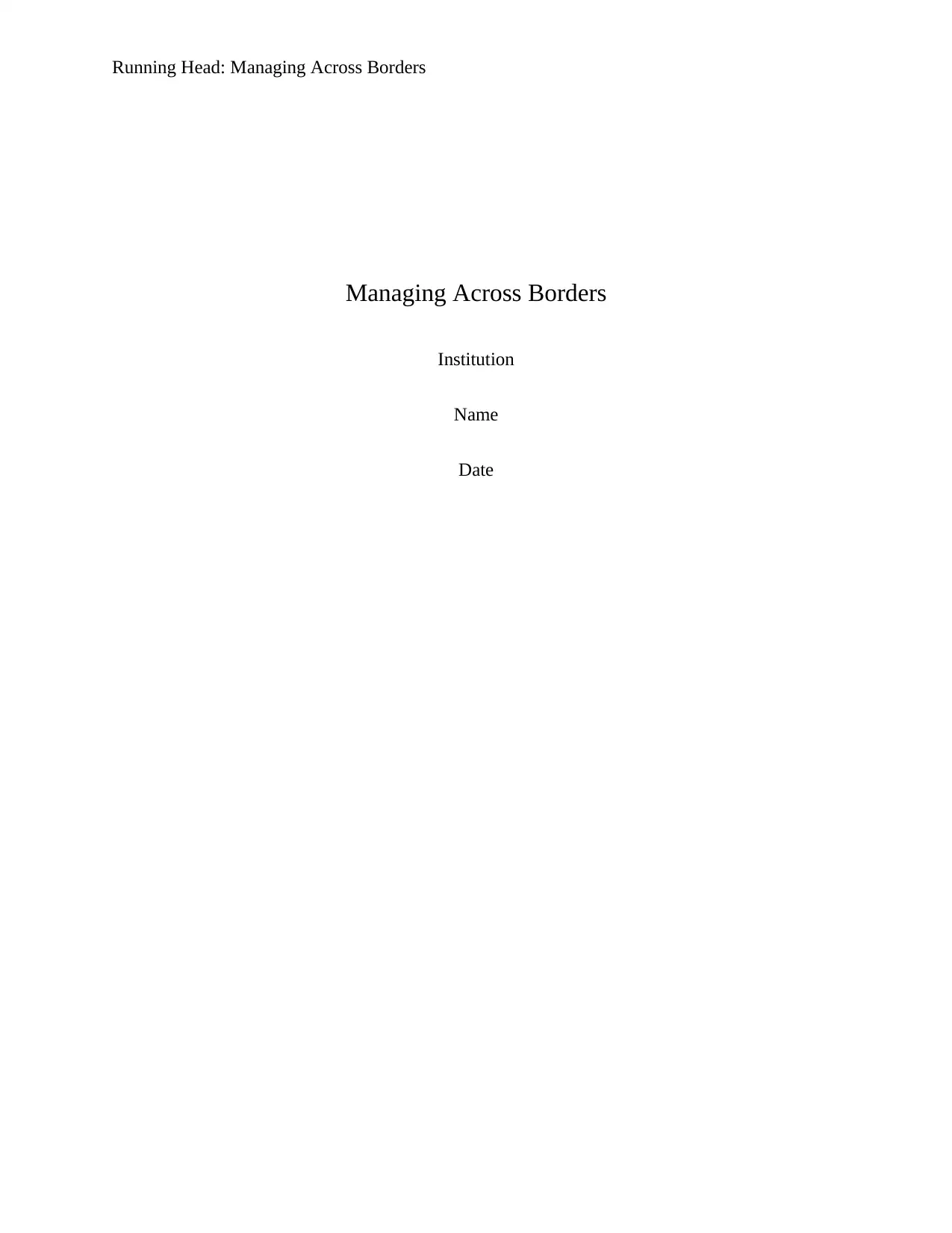
Running Head: Managing Across Borders
Managing Across Borders
Institution
Name
Date
Managing Across Borders
Institution
Name
Date
Secure Best Marks with AI Grader
Need help grading? Try our AI Grader for instant feedback on your assignments.
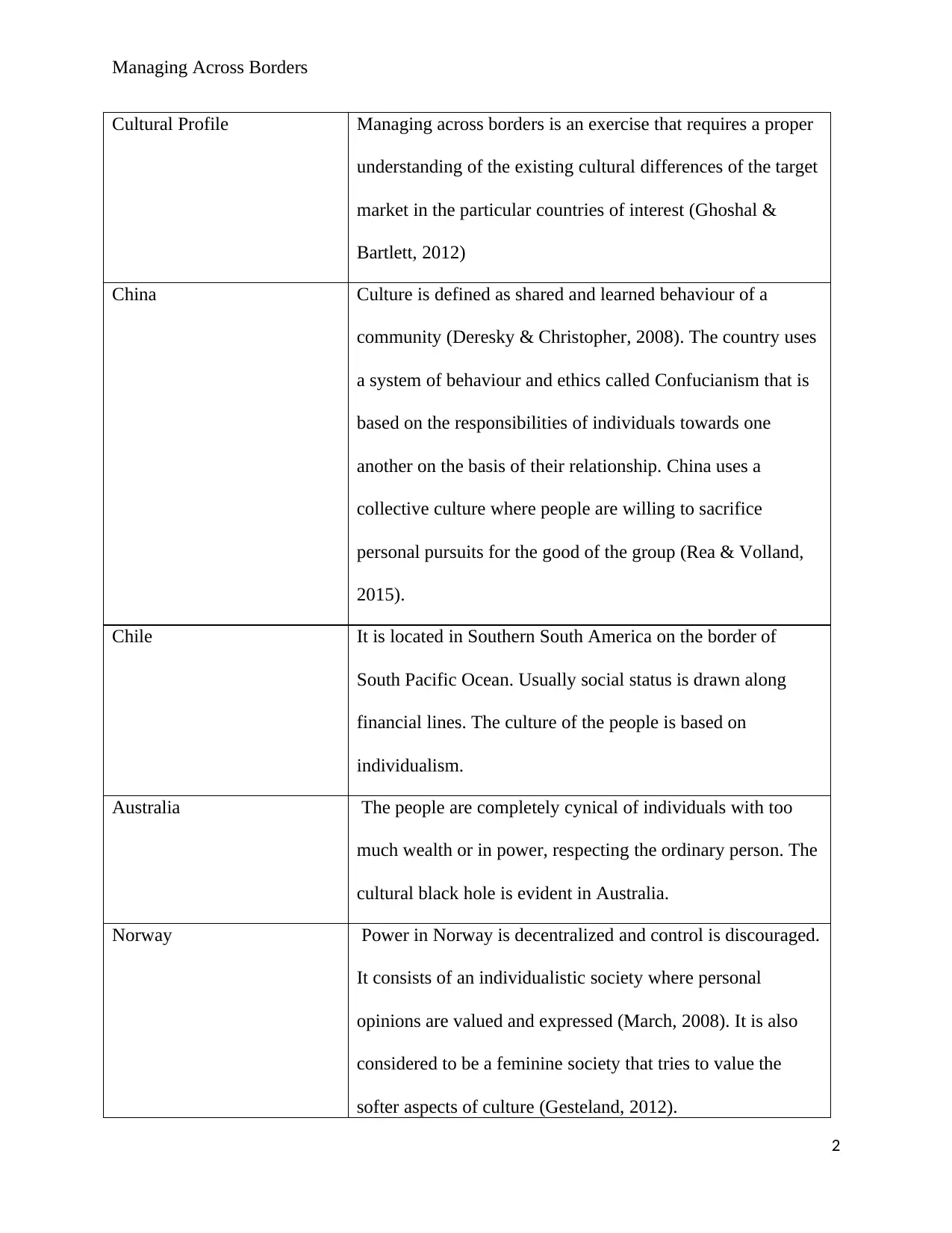
Managing Across Borders
Cultural Profile Managing across borders is an exercise that requires a proper
understanding of the existing cultural differences of the target
market in the particular countries of interest (Ghoshal &
Bartlett, 2012)
China Culture is defined as shared and learned behaviour of a
community (Deresky & Christopher, 2008). The country uses
a system of behaviour and ethics called Confucianism that is
based on the responsibilities of individuals towards one
another on the basis of their relationship. China uses a
collective culture where people are willing to sacrifice
personal pursuits for the good of the group (Rea & Volland,
2015).
Chile It is located in Southern South America on the border of
South Pacific Ocean. Usually social status is drawn along
financial lines. The culture of the people is based on
individualism.
Australia The people are completely cynical of individuals with too
much wealth or in power, respecting the ordinary person. The
cultural black hole is evident in Australia.
Norway Power in Norway is decentralized and control is discouraged.
It consists of an individualistic society where personal
opinions are valued and expressed (March, 2008). It is also
considered to be a feminine society that tries to value the
softer aspects of culture (Gesteland, 2012).
2
Cultural Profile Managing across borders is an exercise that requires a proper
understanding of the existing cultural differences of the target
market in the particular countries of interest (Ghoshal &
Bartlett, 2012)
China Culture is defined as shared and learned behaviour of a
community (Deresky & Christopher, 2008). The country uses
a system of behaviour and ethics called Confucianism that is
based on the responsibilities of individuals towards one
another on the basis of their relationship. China uses a
collective culture where people are willing to sacrifice
personal pursuits for the good of the group (Rea & Volland,
2015).
Chile It is located in Southern South America on the border of
South Pacific Ocean. Usually social status is drawn along
financial lines. The culture of the people is based on
individualism.
Australia The people are completely cynical of individuals with too
much wealth or in power, respecting the ordinary person. The
cultural black hole is evident in Australia.
Norway Power in Norway is decentralized and control is discouraged.
It consists of an individualistic society where personal
opinions are valued and expressed (March, 2008). It is also
considered to be a feminine society that tries to value the
softer aspects of culture (Gesteland, 2012).
2
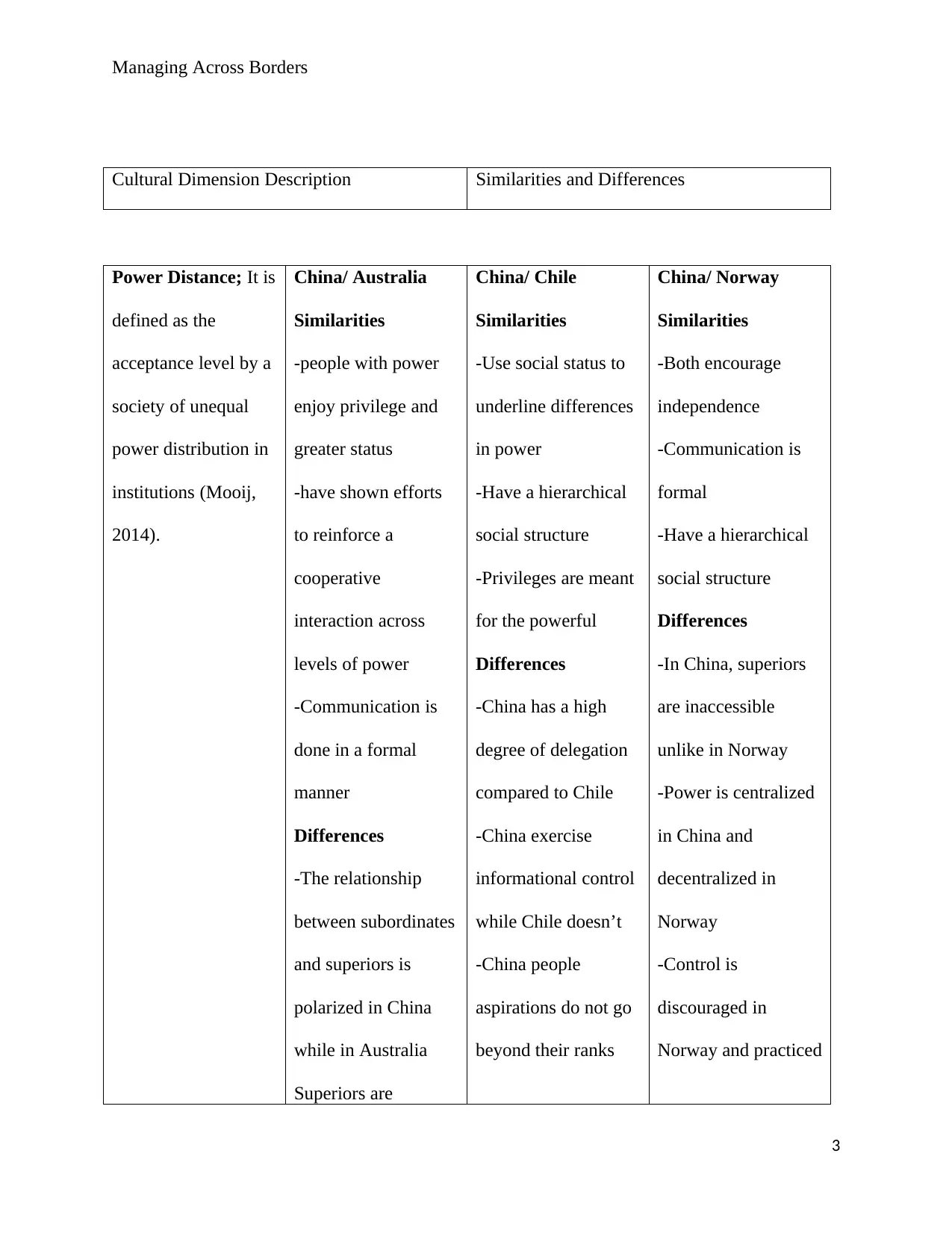
Managing Across Borders
Cultural Dimension Description Similarities and Differences
Power Distance; It is
defined as the
acceptance level by a
society of unequal
power distribution in
institutions (Mooij,
2014).
China/ Australia
Similarities
-people with power
enjoy privilege and
greater status
-have shown efforts
to reinforce a
cooperative
interaction across
levels of power
-Communication is
done in a formal
manner
Differences
-The relationship
between subordinates
and superiors is
polarized in China
while in Australia
Superiors are
China/ Chile
Similarities
-Use social status to
underline differences
in power
-Have a hierarchical
social structure
-Privileges are meant
for the powerful
Differences
-China has a high
degree of delegation
compared to Chile
-China exercise
informational control
while Chile doesn’t
-China people
aspirations do not go
beyond their ranks
China/ Norway
Similarities
-Both encourage
independence
-Communication is
formal
-Have a hierarchical
social structure
Differences
-In China, superiors
are inaccessible
unlike in Norway
-Power is centralized
in China and
decentralized in
Norway
-Control is
discouraged in
Norway and practiced
3
Cultural Dimension Description Similarities and Differences
Power Distance; It is
defined as the
acceptance level by a
society of unequal
power distribution in
institutions (Mooij,
2014).
China/ Australia
Similarities
-people with power
enjoy privilege and
greater status
-have shown efforts
to reinforce a
cooperative
interaction across
levels of power
-Communication is
done in a formal
manner
Differences
-The relationship
between subordinates
and superiors is
polarized in China
while in Australia
Superiors are
China/ Chile
Similarities
-Use social status to
underline differences
in power
-Have a hierarchical
social structure
-Privileges are meant
for the powerful
Differences
-China has a high
degree of delegation
compared to Chile
-China exercise
informational control
while Chile doesn’t
-China people
aspirations do not go
beyond their ranks
China/ Norway
Similarities
-Both encourage
independence
-Communication is
formal
-Have a hierarchical
social structure
Differences
-In China, superiors
are inaccessible
unlike in Norway
-Power is centralized
in China and
decentralized in
Norway
-Control is
discouraged in
Norway and practiced
3
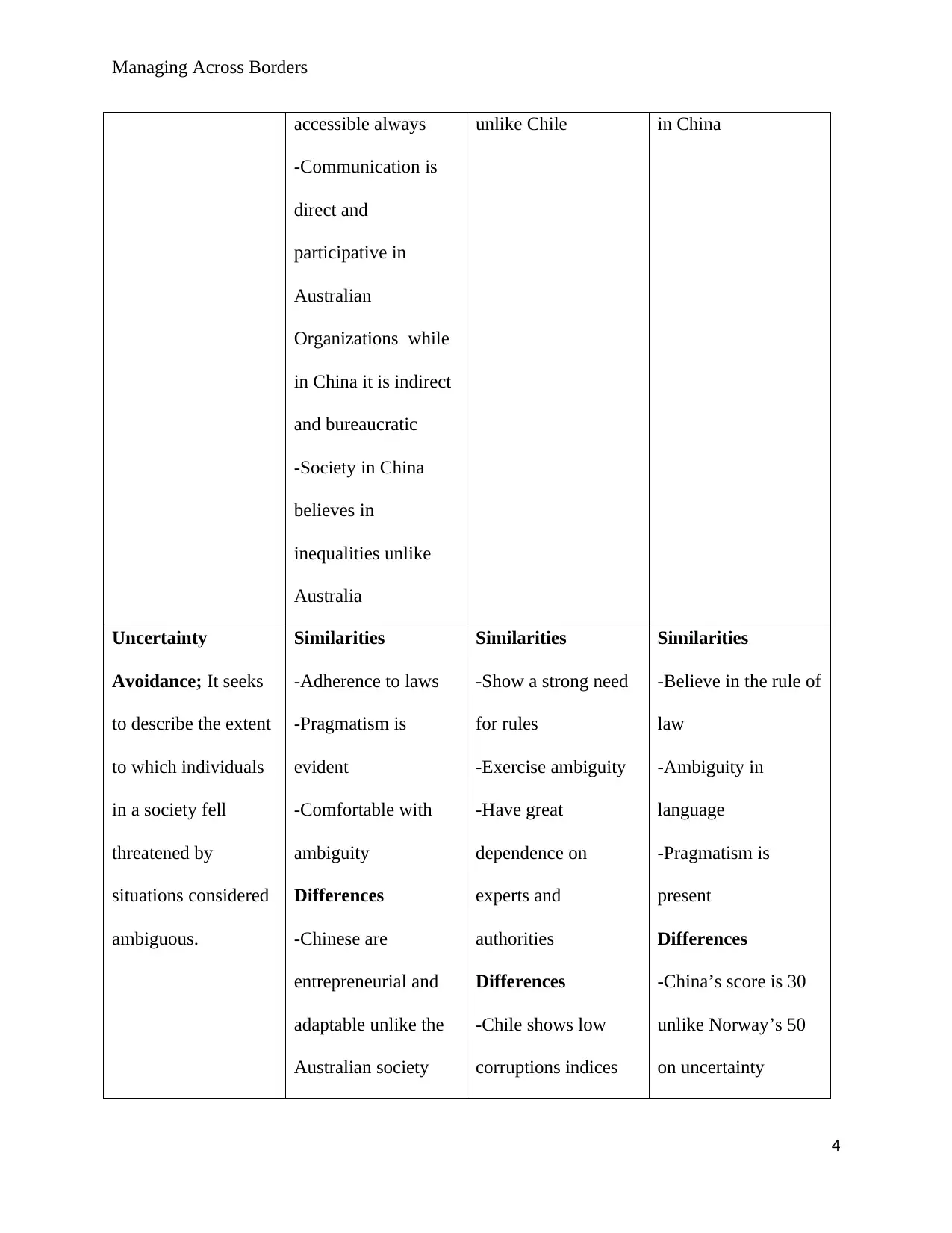
Managing Across Borders
accessible always
-Communication is
direct and
participative in
Australian
Organizations while
in China it is indirect
and bureaucratic
-Society in China
believes in
inequalities unlike
Australia
unlike Chile in China
Uncertainty
Avoidance; It seeks
to describe the extent
to which individuals
in a society fell
threatened by
situations considered
ambiguous.
Similarities
-Adherence to laws
-Pragmatism is
evident
-Comfortable with
ambiguity
Differences
-Chinese are
entrepreneurial and
adaptable unlike the
Australian society
Similarities
-Show a strong need
for rules
-Exercise ambiguity
-Have great
dependence on
experts and
authorities
Differences
-Chile shows low
corruptions indices
Similarities
-Believe in the rule of
law
-Ambiguity in
language
-Pragmatism is
present
Differences
-China’s score is 30
unlike Norway’s 50
on uncertainty
4
accessible always
-Communication is
direct and
participative in
Australian
Organizations while
in China it is indirect
and bureaucratic
-Society in China
believes in
inequalities unlike
Australia
unlike Chile in China
Uncertainty
Avoidance; It seeks
to describe the extent
to which individuals
in a society fell
threatened by
situations considered
ambiguous.
Similarities
-Adherence to laws
-Pragmatism is
evident
-Comfortable with
ambiguity
Differences
-Chinese are
entrepreneurial and
adaptable unlike the
Australian society
Similarities
-Show a strong need
for rules
-Exercise ambiguity
-Have great
dependence on
experts and
authorities
Differences
-Chile shows low
corruptions indices
Similarities
-Believe in the rule of
law
-Ambiguity in
language
-Pragmatism is
present
Differences
-China’s score is 30
unlike Norway’s 50
on uncertainty
4
Secure Best Marks with AI Grader
Need help grading? Try our AI Grader for instant feedback on your assignments.
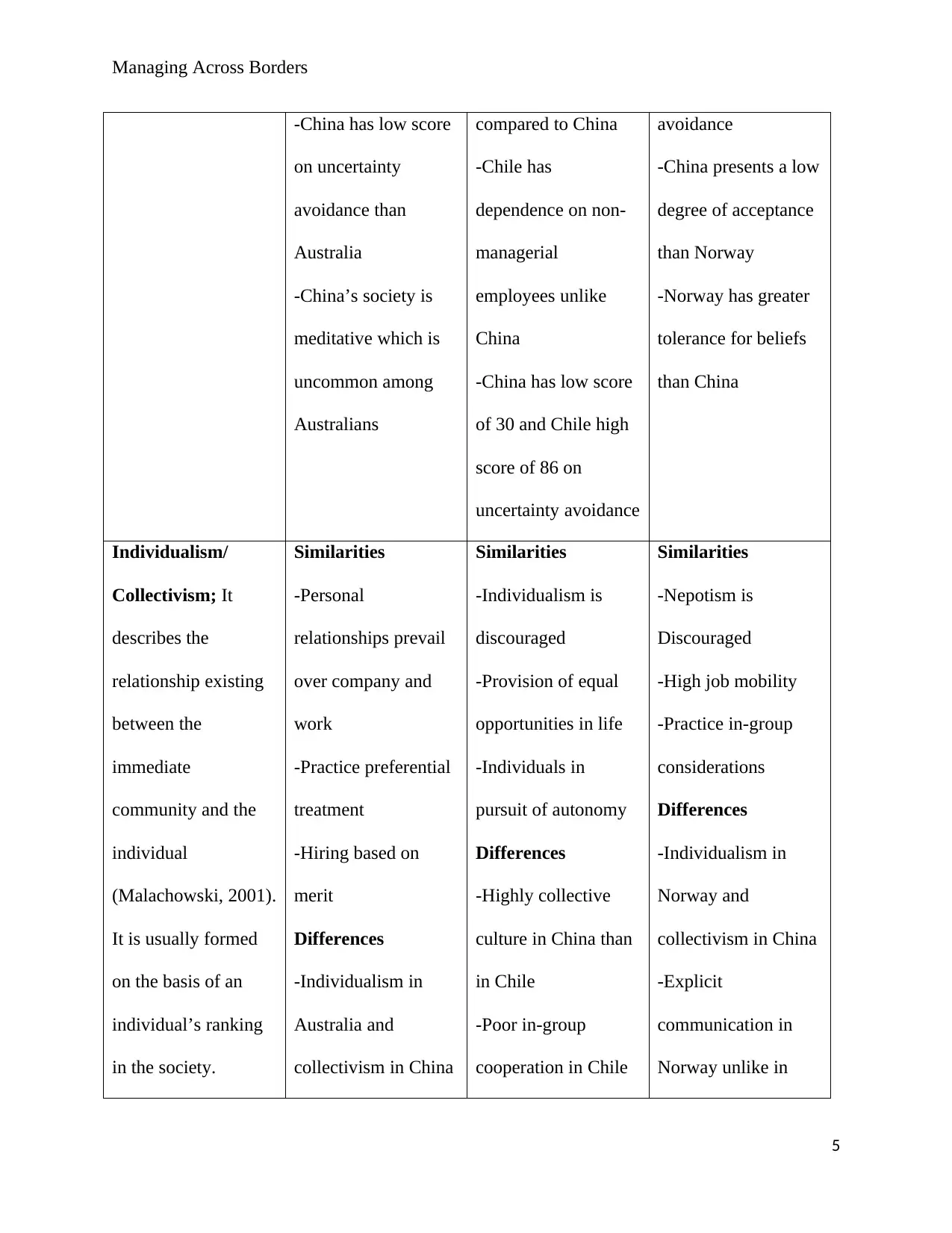
Managing Across Borders
-China has low score
on uncertainty
avoidance than
Australia
-China’s society is
meditative which is
uncommon among
Australians
compared to China
-Chile has
dependence on non-
managerial
employees unlike
China
-China has low score
of 30 and Chile high
score of 86 on
uncertainty avoidance
avoidance
-China presents a low
degree of acceptance
than Norway
-Norway has greater
tolerance for beliefs
than China
Individualism/
Collectivism; It
describes the
relationship existing
between the
immediate
community and the
individual
(Malachowski, 2001).
It is usually formed
on the basis of an
individual’s ranking
in the society.
Similarities
-Personal
relationships prevail
over company and
work
-Practice preferential
treatment
-Hiring based on
merit
Differences
-Individualism in
Australia and
collectivism in China
Similarities
-Individualism is
discouraged
-Provision of equal
opportunities in life
-Individuals in
pursuit of autonomy
Differences
-Highly collective
culture in China than
in Chile
-Poor in-group
cooperation in Chile
Similarities
-Nepotism is
Discouraged
-High job mobility
-Practice in-group
considerations
Differences
-Individualism in
Norway and
collectivism in China
-Explicit
communication in
Norway unlike in
5
-China has low score
on uncertainty
avoidance than
Australia
-China’s society is
meditative which is
uncommon among
Australians
compared to China
-Chile has
dependence on non-
managerial
employees unlike
China
-China has low score
of 30 and Chile high
score of 86 on
uncertainty avoidance
avoidance
-China presents a low
degree of acceptance
than Norway
-Norway has greater
tolerance for beliefs
than China
Individualism/
Collectivism; It
describes the
relationship existing
between the
immediate
community and the
individual
(Malachowski, 2001).
It is usually formed
on the basis of an
individual’s ranking
in the society.
Similarities
-Personal
relationships prevail
over company and
work
-Practice preferential
treatment
-Hiring based on
merit
Differences
-Individualism in
Australia and
collectivism in China
Similarities
-Individualism is
discouraged
-Provision of equal
opportunities in life
-Individuals in
pursuit of autonomy
Differences
-Highly collective
culture in China than
in Chile
-Poor in-group
cooperation in Chile
Similarities
-Nepotism is
Discouraged
-High job mobility
-Practice in-group
considerations
Differences
-Individualism in
Norway and
collectivism in China
-Explicit
communication in
Norway unlike in
5
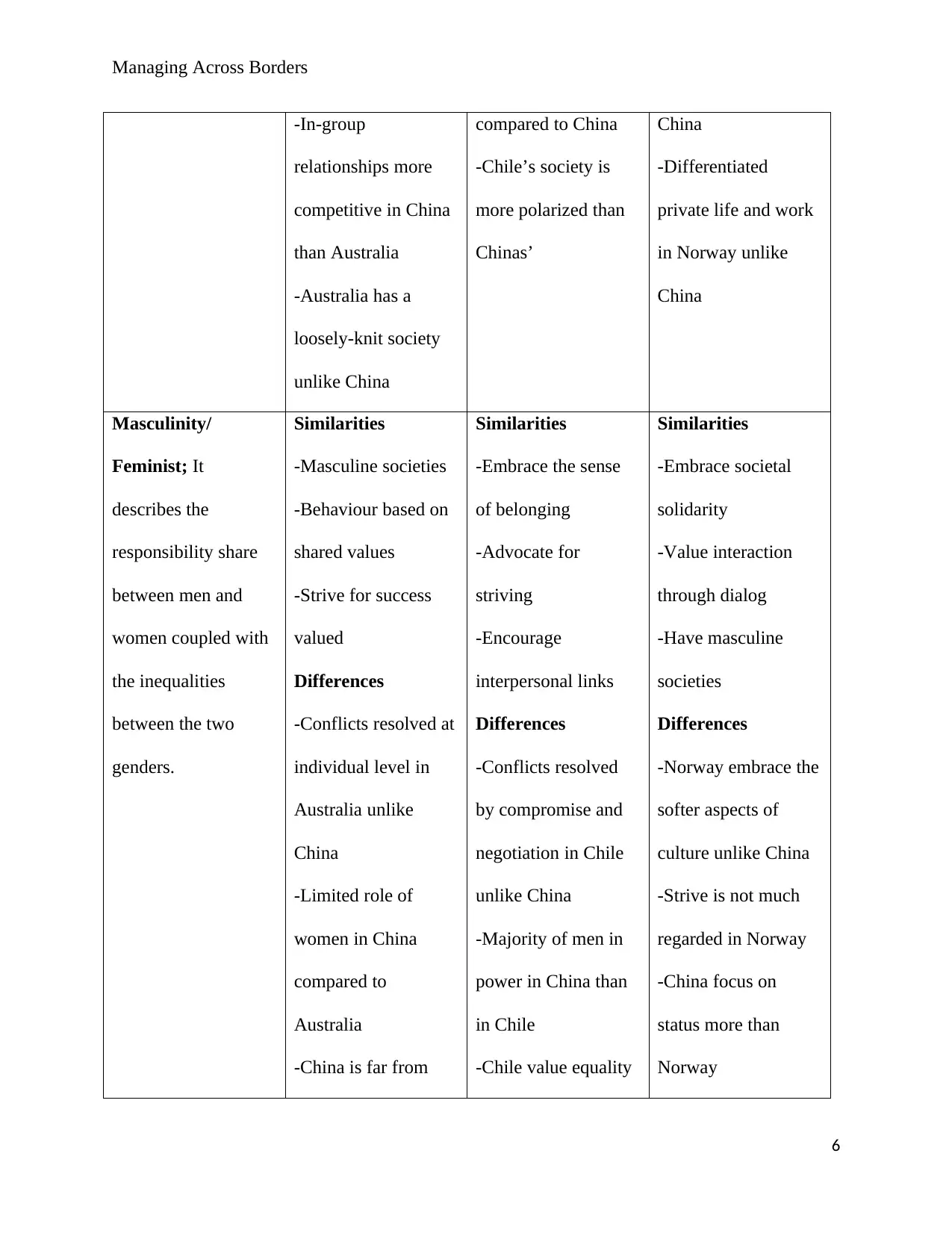
Managing Across Borders
-In-group
relationships more
competitive in China
than Australia
-Australia has a
loosely-knit society
unlike China
compared to China
-Chile’s society is
more polarized than
Chinas’
China
-Differentiated
private life and work
in Norway unlike
China
Masculinity/
Feminist; It
describes the
responsibility share
between men and
women coupled with
the inequalities
between the two
genders.
Similarities
-Masculine societies
-Behaviour based on
shared values
-Strive for success
valued
Differences
-Conflicts resolved at
individual level in
Australia unlike
China
-Limited role of
women in China
compared to
Australia
-China is far from
Similarities
-Embrace the sense
of belonging
-Advocate for
striving
-Encourage
interpersonal links
Differences
-Conflicts resolved
by compromise and
negotiation in Chile
unlike China
-Majority of men in
power in China than
in Chile
-Chile value equality
Similarities
-Embrace societal
solidarity
-Value interaction
through dialog
-Have masculine
societies
Differences
-Norway embrace the
softer aspects of
culture unlike China
-Strive is not much
regarded in Norway
-China focus on
status more than
Norway
6
-In-group
relationships more
competitive in China
than Australia
-Australia has a
loosely-knit society
unlike China
compared to China
-Chile’s society is
more polarized than
Chinas’
China
-Differentiated
private life and work
in Norway unlike
China
Masculinity/
Feminist; It
describes the
responsibility share
between men and
women coupled with
the inequalities
between the two
genders.
Similarities
-Masculine societies
-Behaviour based on
shared values
-Strive for success
valued
Differences
-Conflicts resolved at
individual level in
Australia unlike
China
-Limited role of
women in China
compared to
Australia
-China is far from
Similarities
-Embrace the sense
of belonging
-Advocate for
striving
-Encourage
interpersonal links
Differences
-Conflicts resolved
by compromise and
negotiation in Chile
unlike China
-Majority of men in
power in China than
in Chile
-Chile value equality
Similarities
-Embrace societal
solidarity
-Value interaction
through dialog
-Have masculine
societies
Differences
-Norway embrace the
softer aspects of
culture unlike China
-Strive is not much
regarded in Norway
-China focus on
status more than
Norway
6
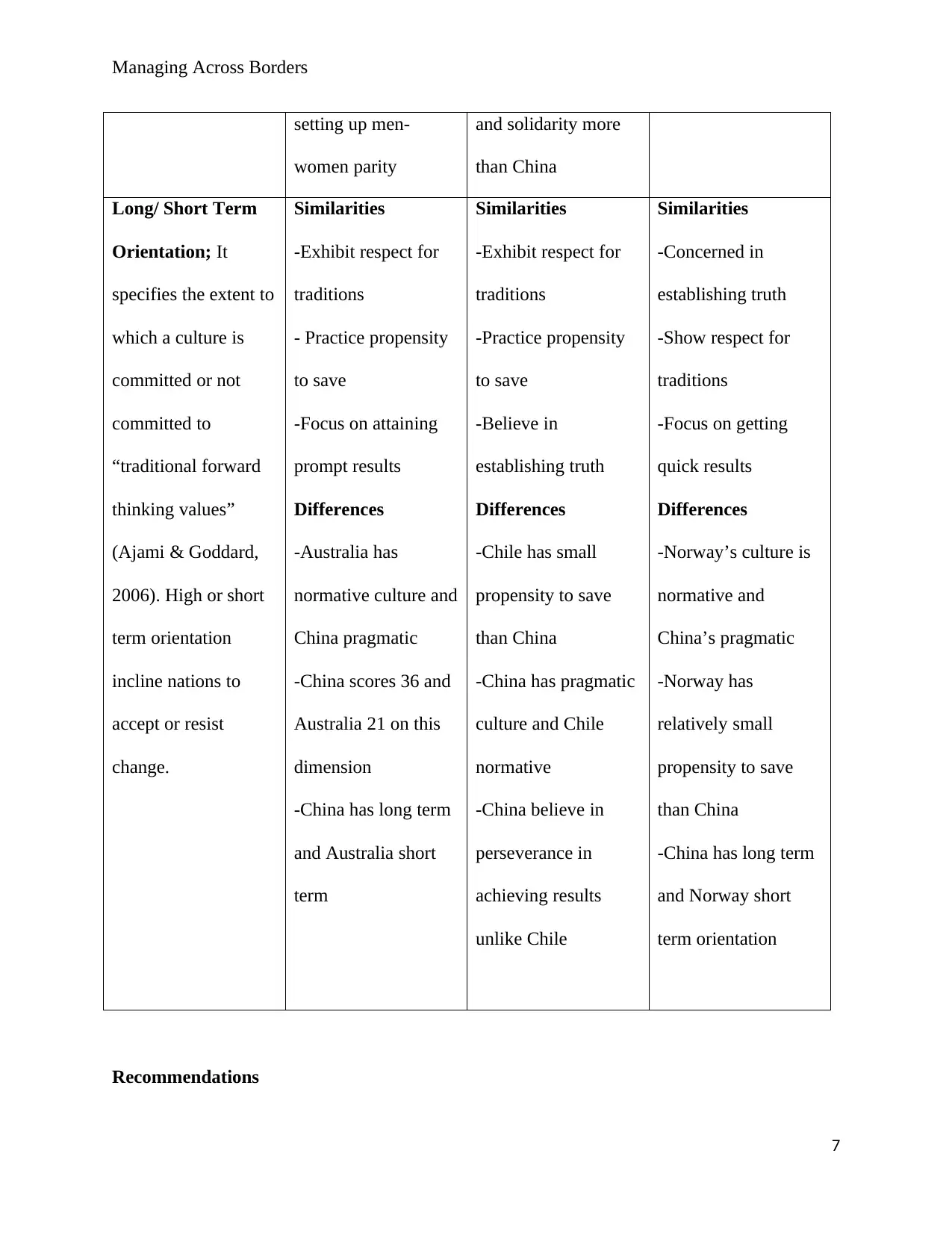
Managing Across Borders
setting up men-
women parity
and solidarity more
than China
Long/ Short Term
Orientation; It
specifies the extent to
which a culture is
committed or not
committed to
“traditional forward
thinking values”
(Ajami & Goddard,
2006). High or short
term orientation
incline nations to
accept or resist
change.
Similarities
-Exhibit respect for
traditions
- Practice propensity
to save
-Focus on attaining
prompt results
Differences
-Australia has
normative culture and
China pragmatic
-China scores 36 and
Australia 21 on this
dimension
-China has long term
and Australia short
term
Similarities
-Exhibit respect for
traditions
-Practice propensity
to save
-Believe in
establishing truth
Differences
-Chile has small
propensity to save
than China
-China has pragmatic
culture and Chile
normative
-China believe in
perseverance in
achieving results
unlike Chile
Similarities
-Concerned in
establishing truth
-Show respect for
traditions
-Focus on getting
quick results
Differences
-Norway’s culture is
normative and
China’s pragmatic
-Norway has
relatively small
propensity to save
than China
-China has long term
and Norway short
term orientation
Recommendations
7
setting up men-
women parity
and solidarity more
than China
Long/ Short Term
Orientation; It
specifies the extent to
which a culture is
committed or not
committed to
“traditional forward
thinking values”
(Ajami & Goddard,
2006). High or short
term orientation
incline nations to
accept or resist
change.
Similarities
-Exhibit respect for
traditions
- Practice propensity
to save
-Focus on attaining
prompt results
Differences
-Australia has
normative culture and
China pragmatic
-China scores 36 and
Australia 21 on this
dimension
-China has long term
and Australia short
term
Similarities
-Exhibit respect for
traditions
-Practice propensity
to save
-Believe in
establishing truth
Differences
-Chile has small
propensity to save
than China
-China has pragmatic
culture and Chile
normative
-China believe in
perseverance in
achieving results
unlike Chile
Similarities
-Concerned in
establishing truth
-Show respect for
traditions
-Focus on getting
quick results
Differences
-Norway’s culture is
normative and
China’s pragmatic
-Norway has
relatively small
propensity to save
than China
-China has long term
and Norway short
term orientation
Recommendations
7
Paraphrase This Document
Need a fresh take? Get an instant paraphrase of this document with our AI Paraphraser

Managing Across Borders
1. There is the need to address the language barrier considering that Chile and Norway
speak different languages which is spoken by majority of their citizens. It is important for
the senior management to hire people who can carry out the responsibility of interpreting
as an effective translator to communicate with the locals. Therefore, adequate funds
should be allocated for this exercise together with promoting the interpreters with all the
relevant information for them to effectively execute their tasks in regard to venturing
these new markets. It is also advisable for the company to create sufficient time to discuss
with the hired interpreters the set out objectives before each of the planned meetings to
avert any negotiations.
2. There is the need to create balance in investing in those countries by understanding their
business culture. This move will contribute to doing business with the three countries in
the long run. For instance, they have shown adherence to the rule of law and portrayed
hierarchical societal structure even in their local organizations. It will assist the company
understand how the market operate in these nations. Looking at Chile, Norway and
Australia, there is similarity in the way the workforce operate hence making it easy to
venture in these markets. The company therefore needs to capitalize on this part for the
investment to proceed immediately.
3. There is the need to explore the legal environment by familiarizing with these countries
market laws. Therefore, interacting with the locals will facilitate a better understanding of
the said nations’ business culture and law which is useful for conducting business. It
would be important to partner with local companies to assist in the process of registration
and negotiation with the relevant authorities of these nations.
8
1. There is the need to address the language barrier considering that Chile and Norway
speak different languages which is spoken by majority of their citizens. It is important for
the senior management to hire people who can carry out the responsibility of interpreting
as an effective translator to communicate with the locals. Therefore, adequate funds
should be allocated for this exercise together with promoting the interpreters with all the
relevant information for them to effectively execute their tasks in regard to venturing
these new markets. It is also advisable for the company to create sufficient time to discuss
with the hired interpreters the set out objectives before each of the planned meetings to
avert any negotiations.
2. There is the need to create balance in investing in those countries by understanding their
business culture. This move will contribute to doing business with the three countries in
the long run. For instance, they have shown adherence to the rule of law and portrayed
hierarchical societal structure even in their local organizations. It will assist the company
understand how the market operate in these nations. Looking at Chile, Norway and
Australia, there is similarity in the way the workforce operate hence making it easy to
venture in these markets. The company therefore needs to capitalize on this part for the
investment to proceed immediately.
3. There is the need to explore the legal environment by familiarizing with these countries
market laws. Therefore, interacting with the locals will facilitate a better understanding of
the said nations’ business culture and law which is useful for conducting business. It
would be important to partner with local companies to assist in the process of registration
and negotiation with the relevant authorities of these nations.
8
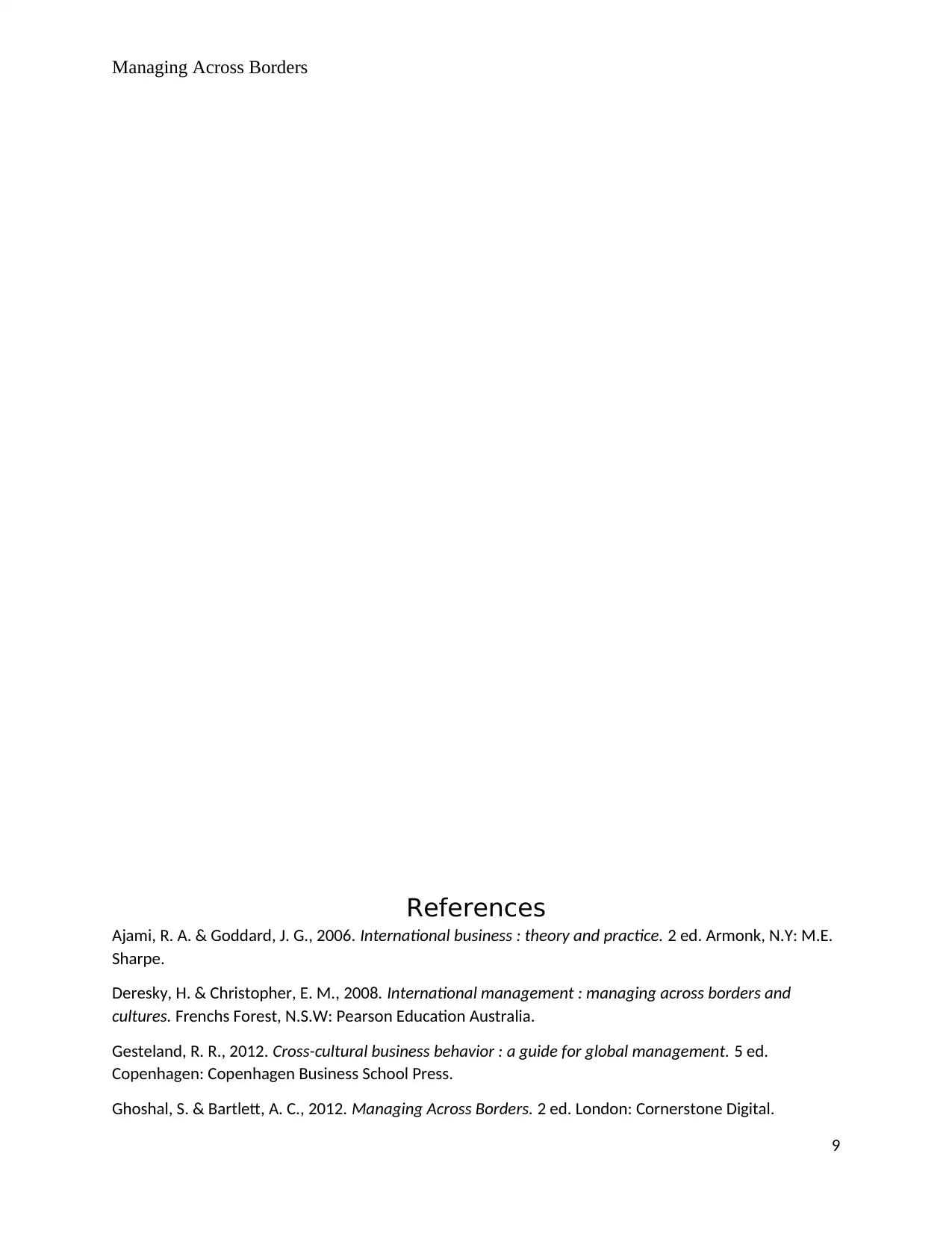
Managing Across Borders
References
Ajami, R. A. & Goddard, J. G., 2006. International business : theory and practice. 2 ed. Armonk, N.Y: M.E.
Sharpe.
Deresky, H. & Christopher, E. M., 2008. International management : managing across borders and
cultures. Frenchs Forest, N.S.W: Pearson Education Australia.
Gesteland, R. R., 2012. Cross-cultural business behavior : a guide for global management. 5 ed.
Copenhagen: Copenhagen Business School Press.
Ghoshal, S. & Bartlett, A. C., 2012. Managing Across Borders. 2 ed. London: Cornerstone Digital.
9
References
Ajami, R. A. & Goddard, J. G., 2006. International business : theory and practice. 2 ed. Armonk, N.Y: M.E.
Sharpe.
Deresky, H. & Christopher, E. M., 2008. International management : managing across borders and
cultures. Frenchs Forest, N.S.W: Pearson Education Australia.
Gesteland, R. R., 2012. Cross-cultural business behavior : a guide for global management. 5 ed.
Copenhagen: Copenhagen Business School Press.
Ghoshal, S. & Bartlett, A. C., 2012. Managing Across Borders. 2 ed. London: Cornerstone Digital.
9

Managing Across Borders
Malachowski, A. R., 2001. Business Ethics: Critical Perspectives on Business and Management. s.l.:Taylor
& Francis.
March, L. D., 2008. Norway. London : Kuperard.
Mooij, M. K. d., 2014. Global marketing and advertising : understanding cultural paradoxes. 4 ed.
Thousand Oaks, Calif.: SAGE.
Rea, C. G. & Volland, N., 2015. The business of culture : cultural entrepreneurs in China and Southeast
Asia. Vancouver: UBC Press.
10
Malachowski, A. R., 2001. Business Ethics: Critical Perspectives on Business and Management. s.l.:Taylor
& Francis.
March, L. D., 2008. Norway. London : Kuperard.
Mooij, M. K. d., 2014. Global marketing and advertising : understanding cultural paradoxes. 4 ed.
Thousand Oaks, Calif.: SAGE.
Rea, C. G. & Volland, N., 2015. The business of culture : cultural entrepreneurs in China and Southeast
Asia. Vancouver: UBC Press.
10
1 out of 10
Related Documents
Your All-in-One AI-Powered Toolkit for Academic Success.
+13062052269
info@desklib.com
Available 24*7 on WhatsApp / Email
![[object Object]](/_next/static/media/star-bottom.7253800d.svg)
Unlock your academic potential
© 2024 | Zucol Services PVT LTD | All rights reserved.




